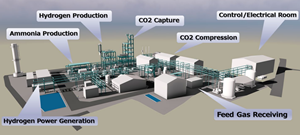News
INPEX commences construction of Kashiwazaki clean H2 and ammonia project
INPEX held a groundbreaking ceremony to commence construction of surface plant facilities of the Kashiwazaki clean H2 ammonia project to be implemented at the INPEX-owned Higashi-Kashiwazaki Gas Field in the Hirai district of Kashiwazaki City, Niigata Prefecture, Japan. The project is the first in Japan to build an integrated H2 and ammonia value chain from production to usage. H2 and ammonia are forms of clean energy that do not generate CO2 when used.
Natural gas produced in Niigata Prefecture will be used as a raw material to produce the H2 and ammonia. The CO2 generated during the production process will be separated, pressurized and injected in the Higashi-Kashiwazaki Gas Field Reservoir, a subsurface gas reservoir where gas production has terminated, as a carbon capture, utilization and storage (CCUS) effort. H2 produced in this manner is referred to as blue H2.
Blue H2 produced in this demonstration test will be converted into electricity through a H2 power generation system and supplied to end users in Niigata Prefecture. Some of the blue H2 will be used to produce blue ammonia with the aim of supplying it for fertilizer use to consumers also in Niigata Prefecture.
Through the project, INPEX will contribute to enhancing Japan’s energy security by realizing clean energy production from domestic gas. In addition, INPEX will use its findings from the project to build a blue H2 production plant in Niigata Prefecture utilizing its natural gas field and existing infrastructure, aiming for commercialization by around 2030. The company will also continue to study opportunities for blue H2/ammonia and CCS/CCUS projects internationally, leveraging the knowledge and experience gained from this project.
The surface plant facilities will have an annual production scale of 700 t, infrastructure to separate and capture CO2 generated during H2 production, CO2 subsurface injection infrastructure and facilities to produce, store and ship ammonia. All these features involve advanced technologies contributing to a low-carbon society.
The H2 production facility will use Air Liquide Global E&C Solutions’ autothermal reforming (ATR) technology, which can reduce the energy required to separate CO2 during H2 production. The CO2 separation/capture facility will adopt a process called HiPACT by JGC Global/BASF, which enables the reduction of power required to pressurize CO2 by recovering CO2 at high pressure.
The ammonia production facility adopts the technology of Tsubame BHB Co., Ltd., which makes it possible to synthesize ammonia at low temperature and low pressure by adopting a unique catalyst. Daiichi Jitsugyo Co., Ltd. will handle the design, equipment procurement, construction work, and commissioning services related to these facilities. JGC Corporation will construct H2 production equipment, CO2 separation/recovery equipment, underground injection equipment, and other equipment.
Preparatory work for the surface plant facilities will begin in June 2023, and the main construction work will begin in July 2023. Commissioning will begin in March 2025, with the aim of completing construction in August 2025. In constructing the surface plant, the company will give due consideration to safety and the environment.
The project’s H2 and ammonia production and CO2 recovery will be subsidized by the New Energy and Industrial Technology Development Organization (NEDO) as an initiative for technology development for the utilization and production of ammonia as fuel/technology development for blue ammonia production.
In addition, INPEX will conduct joint research with Japan Organization for Metals and Energy Security (JOGMEC) on the evaluation and implementation of subsurface storage of CO2 as part of the demonstration test on identifying possible CO2 storage solutions utilizing domestic depleted oil and gas fields.


